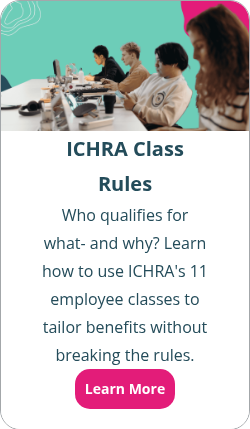Does ICHRA work with group health insurance?
By Elizabeth Walker on May 21, 2025 at 9:15 AM
Today’s workforce is diverse and unique. To meet the growing needs of these employees, many employers seek out flexible and personalized health benefit plans. Offering these benefits can provide a competitive edge. If you’re looking at alternatives to group coverage, a question often arises: “Can I offer an individual coverage health reimbursement arrangement (ICHRA) alongside a traditional group health plan?” The answer is yes—but only if you structure it right.
Whether you're looking to boost your benefit offerings or better meet your employees’ medical needs, understanding how to offer these attractive options can help you build a more robust compensation package. In this article, we’ll explain how ICHRA and group health plans can work together and the rules you must know to stay compliant.
In this blog post, you’ll learn:
- How the ICHRA works to give employees the freedom to choose their health coverage and other eligible expenses.
- The coordination requirements for offering both an ICHRA and group health insurance.
- Which types of health insurance policies your employees can choose from to use the ICHRA.
What is the ICHRA?
An ICHRA is an innovative and cost-effective way for employers to support their team’s healthcare needs without a group health plan. With an ICHRA, employers can reimburse employees tax-free for individual health insurance premiums and out-of-pocket expenses.
Designing an ICHRA is easy. You choose a monthly amount of tax-free money — called an allowance — that employees can use to buy health insurance coverage and qualified medical expenses. Once they submit claim documentation proving they bought an eligible item, you approve it and reimburse them up to their allowance amount.
Below are six standout benefits of offering an ICHRA:
- The ICHRA is available to employers of any size with at least one W-2 employee.
- There are no minimum or maximum employer contribution limits with an ICHRA. You can set whatever allowance that works best for your budget. The ICHRA also has no participation requirements.
- The benefit has flexible plan design options. You can reimburse employees for individual health insurance premiums only or premiums plus other medical expenses. You can also adjust allowances by age, family size, or employee class, such as seasonal or temporary workers.
- ICHRAs also have tax advantages. They’re tax-deductible and free of payroll taxes for business owners. Employees also don’t have to pay income taxes on reimbursements.
- The ICHRA can coordinate with premium tax credits depending on allowance affordability. If it’s affordable, employees must waive their credits to use the benefit. They can opt out of the ICHRA and continue receiving their credits if it's unaffordable.
- Larger employers can offer an affordable ICHRA to satisfy the employer mandate.
The ICHRA highlights employee choice while offering budget control for employers, providing a personalized alternative to the one-size-fits-all approach to health coverage.
What is group health insurance?
Group health insurance is the traditional method of providing employees with comprehensive coverage. With these plans, you choose which health insurance plans to offer to your employees, often at a discounted rate. You can also extend employer-sponsored coverage to eligible employees’ spouses and dependents.
You then pay an insurance carrier monthly premiums in exchange for the provider paying enrolled employees’ medical claims. You can buy a group plan from a health insurance carrier, a licensed agent, or a broker. If you’re a small employer, you can buy a group plan on the Small Business Health Options Program (SHOP) Marketplace.
There is a wide range of traditional group plans to choose from, including:
- Health maintenance organizations (HMOs) policies
- Preferred provider organizations (PPOs) plans
- Exclusive provider organizations (EPOs) policies
- Point of service (POS) plans
- High deductible health plans (HDHPs)
You can also offer self-funded group plans. With these plans, employers directly cover their employees’ medical claims. This can help organizations save money on premiums. However, they come with a lot of risk, especially for small businesses, if they don’t have the capital to cover unexpected claims.
About 154 million people have employer-sponsored group health insurance1. Most Americans are familiar with group plans. So, they see them as a valuable perk and a key recruiting and retention tool. Employers can also share the cost of health plan premiums with employees, reducing the financial burden. But, traditional group health insurance isn’t without its challenges.
Employer-sponsored health coverage has minimum participation rates, high premium costs, and limited flexibility. Employees only have a few health insurance options to choose from. So, coverage may not meet everyone’s needs. Managing group health insurance also requires time and effort. You must be adept at plan selection, enrollment, and negotiating renewal rates. This can be an administrative burden, especially if you have a small HR team with limited resources.
Can the ICHRA work with group health insurance?
Business owners can offer both the ICHRA and an employer-sponsored group health plan at their company. But, you can only offer both plans under specific circumstances.
You can offer group coverage and an ICHRA as long as you don’t provide both options to the same employee class. Essentially, you can’t let your staff choose between group coverage and the ICHRA. Instead, you must offer each class of employee one health benefit plan or the other.
For example, you could provide group coverage to your full-time staff while offering an ICHRA to part-time employees. Or, you could offer an ICHRA to only out-of-state employees and group to in-state workers. But, you're not allowed to give your employees the option to choose between the two.
Minimum class size requirements
If you offer an ICHRA and group health insurance, you may have to meet a minimum class size depending on which classes you use to determine employee eligibility. Minimum class size rules ensure fairness between employee groups. It also prevents employers from shifting only higher-risk individuals to an individual market plan.
Minimum class size requirements apply to the following ICHRA employee classes:
- Salaried workers
- Hourly workers
- Full-time employees
- Part-time workers
- Employees in the same rating area (if smaller than the state level)
Minimum class size rules don’t apply to state-based or multi-state classes.
Below are the minimum class size requirements by company size:
|
Fewer than 100 eligible employees |
Between 100 and 200 eligible employees |
More than 200 eligible employees |
|
At least ten employees in a class |
At least 10% of the total number of employees in a class |
At least 20 employees in a class |
Minimum class size requirements don't apply if you only offer an ICHRA benefit. Class sizes also don’t apply when determining your allowance amounts.
What type of health plan coverage coordinates with the ICHRA?
The employee classes you’ve decided to offer the ICHRA must have a specific type of healthcare plan to use the benefit. They must have a qualifying individual health plan that provides minimum essential coverage (MEC).
Business owners who aren’t W-2 employees, like sole proprietors or S-corp shareholders, can’t use the ICHRA. Uninsured workers, those with traditional group plans, or individuals in a healthcare sharing ministry can’t use an ICHRA unless they also buy qualifying individual health coverage.
Acceptable coverage options for employees looking to take part in an ICHRA include:
- Qualified individual health plans from a public health exchange. This includes the Health Insurance Marketplace and state-based marketplaces
- Individual plans from a private exchange, such as an insurance carrier, broker, or agent
- Medicare Parts A and B together, or Medicare Part C
- ACA-compliant student medical insurance (except for self-insured student health coverage)
- Catastrophic healthcare plans (for qualifying employees)
Participating staff members must regularly confirm they still have qualifying coverage to stay compliant. Without it, you can’t continue providing reimbursements to employees for healthcare costs.
Conclusion
Offering both an ICHRA and a traditional group health plan can be a powerful strategy for meeting all your staff’s healthcare needs. But the key to meeting compliance requirements is to coordinate them properly. By understanding the rules around employee classes and minimum class sizes, you can design a customized healthcare benefit while maintaining cost control.
Are you ready to offer an ICHRA? Book a call with one of our HRA specialists today!
Check out more resources
See these related articles

What is a health insurance subsidy?
Discover the ins and outs of health insurance subsidies with this comprehensive overview. Learn how they can help make healthcare more affordable for you.

What is the family glitch, and is it fixed?
Curious about the Family Glitch and its impact on your healthcare coverage? Find out everything you need to know.

How to make individual health insurance work for small employers
Wondering how small businesses can use individual health insurance? Discover strategies to offer flexible, affordable coverage to your employees.



